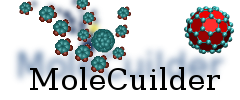| 1 | /*
|
|---|
| 2 | * Project: MoleCuilder
|
|---|
| 3 | * Description: creates and alters molecular systems
|
|---|
| 4 | * Copyright (C) 2010 University of Bonn. All rights reserved.
|
|---|
| 5 | * Please see the LICENSE file or "Copyright notice" in builder.cpp for details.
|
|---|
| 6 | */
|
|---|
| 7 |
|
|---|
| 8 | /**
|
|---|
| 9 | * \file filling.dox
|
|---|
| 10 | *
|
|---|
| 11 | * Created on: Jan 16, 2012
|
|---|
| 12 | * Author: heber
|
|---|
| 13 | */
|
|---|
| 14 |
|
|---|
| 15 | /** \page filling Filling a domain
|
|---|
| 16 | *
|
|---|
| 17 | * The idea behind filling a domain is to cluster it with a set of nodes,
|
|---|
| 18 | * i.e. a position in space in such a way that e.g. around node is sufficient
|
|---|
| 19 | * space to fill in the desired molecule. The logic of generating the nodes
|
|---|
| 20 | * is responsible to create them in such a way as to allow for dense (or
|
|---|
| 21 | * whatever specific) filling is desired. However, we must not make it too
|
|---|
| 22 | * complicated. The generation logic for these nodes should concentrate on
|
|---|
| 23 | * filling the specific domain (sphere, ellipsoid, cuboid, pyramid, ...)
|
|---|
| 24 | * in the best possible way.
|
|---|
| 25 | * Whether each node can be filled is then to be decided by a predicate.
|
|---|
| 26 | *
|
|---|
| 27 | * The filling routine uses then both to traverse the given nodes and
|
|---|
| 28 | * evaluate the predicate at each.
|
|---|
| 29 | *
|
|---|
| 30 | * Hence, the filling of a domain is abstracted into the following parts:
|
|---|
| 31 | *
|
|---|
| 32 | * -# \ref Mesh - node containers
|
|---|
| 33 | * -# \ref FillPredicate - predicates
|
|---|
| 34 | * -# \ref Filler - a filling routine which itself requires
|
|---|
| 35 | * -# \ref Cluster - a set of atoms alone(!) inside a specific Shape
|
|---|
| 36 | * -# \ref CopyAtomsInterface - copy Method for atoms used by Cluster::clone
|
|---|
| 37 | * -# \ref Inserter - an insertion routine for the cloned cluster
|
|---|
| 38 | *
|
|---|
| 39 | * \section filling-node-generation Node generation
|
|---|
| 40 | *
|
|---|
| 41 | * The node generation is basically just a point or mesh generator that fills
|
|---|
| 42 | * a specified region (best would be based on the class Shape) with a mesh in
|
|---|
| 43 | * such a way as to fulfill certain criteria:
|
|---|
| 44 | *
|
|---|
| 45 | * -# equidistant
|
|---|
| 46 | * -# containing certain primitive volumes (e.g. for fitting polymers)
|
|---|
| 47 | * -# ...
|
|---|
| 48 | *
|
|---|
| 49 | * \section filling-predicate Predicates
|
|---|
| 50 | *
|
|---|
| 51 | * The Predicate pattern has already been used with Descriptors and Shapes.
|
|---|
| 52 | * These are simply function objects that return a boolean value. I.e. they
|
|---|
| 53 | * decide whether the current node in the mesh is vacant and can be filled or
|
|---|
| 54 | * not. As with the predicate() function in the class Descriptor, these should
|
|---|
| 55 | * be composable via logic operators such as || (or), && (and), ! (not), ...
|
|---|
| 56 | *
|
|---|
| 57 | * Note that each predicate receives on construction all the required
|
|---|
| 58 | * information, e.g. LinkedCell_View or Tesselation references or objects, ...
|
|---|
| 59 | *
|
|---|
| 60 | * \section filling-filling-routine Filling routine
|
|---|
| 61 | *
|
|---|
| 62 | * The filling routine is then simply a function that goes through the given
|
|---|
| 63 | * number of nodes (completely unaware of the geometry) and evaluates for each
|
|---|
| 64 | * point the given predicates (which might be a composition of other predicates).
|
|---|
| 65 | *
|
|---|
| 66 | * It rejects all nodes that evaluate to false, the list of valid points is
|
|---|
| 67 | * then traversed again and at each node a Cluster is created.
|
|---|
| 68 | *
|
|---|
| 69 | * Note that we rely on \ref Cluster's, objects containing a set of atomicId_t
|
|---|
| 70 | * and that are inside a contained \ref Shape, to fill at each node. We use
|
|---|
| 71 | * Cluster::clone() to create a copy that is subsequently placed at the desired
|
|---|
| 72 | * node via an \ref Inserter functor. This allows to either simply shift the
|
|---|
| 73 | * Cluster or even to perform some random translations and rotations on it, see
|
|---|
| 74 | * the specific implementations of the class \ref Inserter.
|
|---|
| 75 | *
|
|---|
| 76 | *
|
|---|
| 77 | * \date 2012-01-16
|
|---|
| 78 | */
|
|---|
